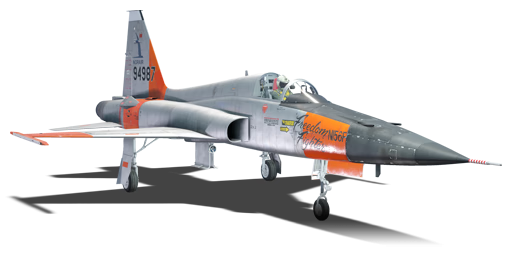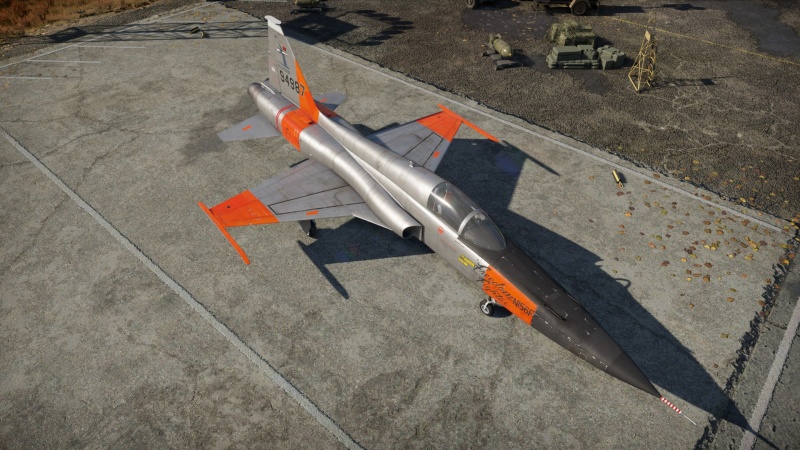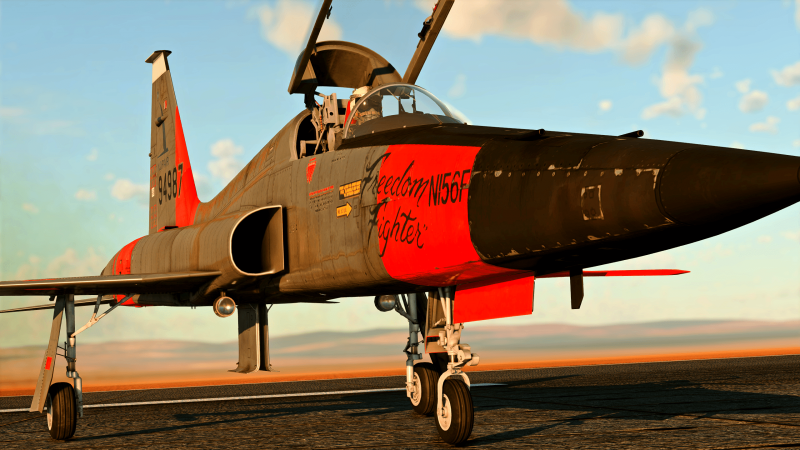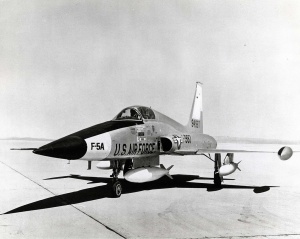Difference between revisions of "F-5A"
Colok76286 (talk | contribs) (Edits) |
Bonisducks (talk | contribs) (→History: Full history added.) (Tag: Visual edit) |
||
| Line 197: | Line 197: | ||
== History == | == History == | ||
<!-- ''Describe the history of the creation and combat usage of the aircraft in more detail than in the introduction. If the historical reference turns out to be too long, take it to a separate article, taking a link to the article about the vehicle and adding a block "/History" (example: <nowiki>https://wiki.warthunder.com/(Vehicle-name)/History</nowiki>) and add a link to it here using the <code>main</code> template. Be sure to reference text and sources by using <code><nowiki><ref></ref></nowiki></code>, as well as adding them at the end of the article with <code><nowiki><references /></nowiki></code>. This section may also include the vehicle's dev blog entry (if applicable) and the in-game encyclopedia description (under <code><nowiki>=== In-game description ===</nowiki></code>, also if applicable).'' --> | <!-- ''Describe the history of the creation and combat usage of the aircraft in more detail than in the introduction. If the historical reference turns out to be too long, take it to a separate article, taking a link to the article about the vehicle and adding a block "/History" (example: <nowiki>https://wiki.warthunder.com/(Vehicle-name)/History</nowiki>) and add a link to it here using the <code>main</code> template. Be sure to reference text and sources by using <code><nowiki><ref></ref></nowiki></code>, as well as adding them at the end of the article with <code><nowiki><references /></nowiki></code>. This section may also include the vehicle's dev blog entry (if applicable) and the in-game encyclopedia description (under <code><nowiki>=== In-game description ===</nowiki></code>, also if applicable).'' --> | ||
| − | + | The F-5A Freedom Fighter is a light fighter designed by Northrop in the 1950s. Designed as a private export venture, the aircraft was designed in both fighter and trainer variants (N-156F and N-156T). The F-5A entered service in the 1960s and was widely exported under the US’s Military Assistance Program to developing countries. The F-5A would later be developed into the more advanced F-5E, and later on, serve as the basis of the YF-17 / F/A-18. | |
| + | |||
| + | === Design and development === | ||
| + | [[File:Northrop YF-5A.jpg|thumb|The first Northrop YF-5A prototype.]] | ||
| + | Design work for the F-5 began in the early 1950s under the leadership of Northrop’s VP of engineering Edgar Schmued, who was well-known for his work in designing the P-51 Mustang and F-86 Sabre with North American Aviation. By 1955, the design team had selected the General Electric J85 engine as the powerplant. That year, the US Navy issued a requirement for a light jet fighter to operate off its escort carriers, and Northrop quickly adapted its prototype design for naval service; however, the Navy requirement disappeared when the escort carriers were retired, and Northrop redesigned its aircraft once again. By this time, the prototypes were designated as the N-156T and N-156F, as trainer and fighter variants, respectively. | ||
| + | |||
| + | The final design of the N-156 would emerge in March of 1956, with a conventional wing design and its two J85 engines mounted in the rear fuselage. While the USAF had little interest in a light fighter such as the N-156F, it selected the N-156T as the replacement of the T-33 Shooting Star, which would go on to enter service as the T-38 Talon. The first YT-38 would fly in July of 1959 and serve as the USAF’s primary trainer, a role it continues to serve today. Meanwhile, the USAF also ordered three N-156F prototypes to fulfil its requirement for a low-cost fighter that could be exported to less developed countries under the Military Assistance Program (MAP). This role was confirmed by the Kennedy administration’s selection of the N-156F as the winner of the F-X competition, for a low-cost fighter to be exported under the MAP program. The N-156F was subsequently renamed the F-5 “Freedom Fighter”. | ||
| + | |||
| + | The F-5A’s design centered on its two J85 engines, each producing up to 22 kn of thrust with afterburner. While initial N-156 prototypes had engines mounted mid-wing and ahead of the tail (similar to the F-4), the final design featured a pair of engines at the rear of the vehicle. The F-5 could attain a speed of Mach 1.4 at high altitude and could carry up to 6200 lbs of ordnance on five underwing hardpoints. Being optimized for ground attack, the F-5 lacked an air-to-air radar. However, it could carry two AIM-9 Sidewinders on wingtip pylons along with its nose-mounted 20 mm cannons. | ||
| + | |||
| + | === Operational service === | ||
| + | Being designed for export, a total of 624 F-5As were produced by Northrop, including 3 YF-5A prototypes. Another 200 F-5B two-seater aircraft were produced, lacking internal cannons but otherwise combat-ready. Additionally, Canadair produced 140 aircraft under license for the Royal Canadian Air Force, while CASA in Spain produced 70 aircraft. The F-5A was widely exported under the MAP program to countries including Iran, South Korea, the Philippines, Turkey, Greece, and the Republic of China, while Norway, Spain and Canada purchased/produced the aircraft directly. With the success of the F-5A, the USAF acquired 12 airframes from the MAP program for combat trials in Vietnam, under the code name “Skoshi Tiger” (“Little Tiger”); this led to the F-5’s “Tiger” nickname. The Skoshi Tigers received modifications to instruments and the addition of a fueling probe, and were redesignated F-5C. | ||
| + | |||
| + | Later on, the F-5A would lead to more advanced variants. In 1970, Northrop won a competition for a new light export fighter, with a much larger focus on air-to-air combat to counter the threat from late-generation MiG-21s. This aircraft was the [[F-5E]]/F, advanced versions of the earlier F-5A/Bs now renamed “Tiger II”. The F-5E was similarly widely-exported and modified versions are still in service with export customers, and several aircraft served with NAS Miramar (the so-called TOPGUN) as adversary aircraft, mimicking the MiG-21. Finally, the F-5A’s airframe served as the basis of several design studies which culminated in the YF-17 “Cobra”, a light fighter that lost the USAF LightWeight Fighter (LWF) competition to the F-16 Fighting Falcon. The YF-17 would later be enlarged into the F/A-18 Hornet, which is operated by the US Navy as a multirole combat aircraft. | ||
== Media == | == Media == | ||
| Line 222: | Line 235: | ||
* [[wt:en/news/7346-development-export-order-f-5a-usa-en|[Devblog] “Export Order”: F-5A (USA)]] | * [[wt:en/news/7346-development-export-order-f-5a-usa-en|[Devblog] “Export Order”: F-5A (USA)]] | ||
| + | === References === | ||
| + | |||
| + | * Sherman, R. (1999, December 27). 5 freedom fighter / tiger. F-5 Tiger - Military Aircraft. Retrieved December 22, 2021, from <nowiki>https://man.fas.org/dod-101/sys/ac/f-5.htm</nowiki> | ||
| + | * Yarrish, G. (2020, February 26). Northrop F-5 Freedom Fighter. Flight Journal. Retrieved December 22, 2021, from <nowiki>https://www.flightjournal.com/northrop-f-5-freedom-fighter/</nowiki> | ||
{{USA jet aircraft}} | {{USA jet aircraft}} | ||
Revision as of 01:44, 24 December 2021
| This page is about the American jet fighter F-5A. For other versions, see F-5 (Family). |
Contents
Description
The F-5A Freedom Fighter is a gift rank VII American jet fighter with a battle rating of 10.0 (AB) and 10.3 (RB/SB). It was introduced during Update "Direct Hit" as a reward for the 2021 Export Order event.
General info
Flight performance
Describe how the aircraft behaves in the air. Speed, manoeuvrability, acceleration and allowable loads - these are the most important characteristics of the vehicle.
| Characteristics | Max Speed (km/h at 10,668 m) |
Max altitude (metres) |
Turn time (seconds) |
Rate of climb (metres/second) |
Take-off run (metres) | |||
|---|---|---|---|---|---|---|---|---|
| AB | RB | AB | RB | AB | RB | |||
| Stock | 1,429 | 1,421 | 15240 | 27.1 | 28.2 | 112.4 | 99.2 | 850 |
| Upgraded | ___ | ___ | __._ | __._ | __._ | __._ | ||
Details
| Features | |||||
|---|---|---|---|---|---|
| Combat flaps | Take-off flaps | Landing flaps | Air brakes | Arrestor gear | Drogue chute |
| ✓ | ✓ | ✓ | ✓ | X | ✓ |
| Limits | ||||||
|---|---|---|---|---|---|---|
| Wings (km/h) | Gear (km/h) | Flaps (km/h) | Max Static G | |||
| Combat | Take-off | Landing | + | - | ||
| 1458 | 444 | 926 | 560 | 555 | ~11 | ~5 |
| Optimal velocities (km/h) | |||
|---|---|---|---|
| Ailerons | Rudder | Elevators | Radiator |
| < 680 | < 750 | < 700 | N/A |
Engine performance
| Engine | Aircraft mass | ||||||
|---|---|---|---|---|---|---|---|
| Engine name | Number | Basic mass | Wing loading (full fuel) | ||||
| General Electric J85-GE-13 | 2 | 4,051 kg | 365 kg/m2 | ||||
| Engine characteristics | Mass with fuel (no weapons load) | Max Takeoff Weight | |||||
| Weight (each) | Type | 11m fuel | 20m fuel | 30m fuel | 37m fuel | ||
| 271 kg | Afterburning axial-flow turbojet | 4,580 kg | 4,992 kg | 5,462 kg | 5,814 kg | 9,000 kg | |
| Maximum engine thrust @ 0 m (RB/SB) | Thrust to weight ratio @ 0 m (WEP) | ||||||
| Condition | 100% | WEP | 11m fuel | 20m fuel | 30m fuel | 37m fuel | MTOW |
| Stationary | 960 kgf | 1,426 kgf | 0.62 | 0.57 | 0.52 | 0.49 | 0.32 |
| Optimal | 1,200 kgf (1,400 km/h) |
2,459 kgf (1,400 km/h) |
1.07 | 0.99 | 0.90 | 0.85 | 0.55 |
Survivability and armour
The F-5A has neiter armour plates nor bulletproof glass and the fuel tanks are self-sealing.
Modifications and economy
Armaments
Offensive armament
The F-5A is armed with:
- A choice between two presets:
- 2 x 20 mm M39A2 cannons, nose-mounted (280 rpg = 560 total)
- 2 x 20 mm M39A2 cannons (280 rpg = 560 total) + 60 x countermeasures
Suspended armament
The F-5A can be outfitted with the following ordnance:
- Without load
- 2 x AIM-9B Sidewinder missiles
- 18 x 250 lb LDGP Mk 81 bombs (4,500 lb total)
- 5 x 500 lb LDGP Mk 82 bombs (2,500 lb total)
- 5 x 750 lb M117 cone 45 bombs (3,750 lb total)
- 3 x 1,000 lb LDGP Mk 83 bombs (3,000 lb total)
- 1 x 2,000 lb LDGP Mk 84 bomb (2,000 lb total)
- 8 x Zuni Mk32 Mod 0 ATAP rockets
- 76 x FFAR Mighty Mouse rockets
- 4 x AGM-12B Bullpup missiles
- 2 x AIM-9E Sidewinder missiles + 18 x 250 lb LDGP Mk 81 bombs (4,500 lb total)
- 2 x AIM-9E Sidewinder missiles + 5 x 500 lb LDGP Mk 82 bombs (2,500 lb total)
- 2 x AIM-9E Sidewinder missiles + 5 x 750 lb M117 cone 45 bombs (3,750 lb total)
- 2 x AIM-9E Sidewinder missiles + 3 x 1,000 lb LDGP Mk 83 bombs (3,000 lb total)
- 1 x 2,000 lb LDGP Mk 84 bomb + 2 x AIM-9B Sidewinder missiles (2,000 lb total)
- 2 x AIM-9E Sidewinder missiles + 76 x FFAR Mighty Mouse rockets
- 8 x Zuni Mk32 Mod 0 ATAP rockets + 2 x AIM-9E Sidewinder missiles
- 8 x Zuni Mk32 Mod 0 ATAP rockets + 2 x AGM-12B Bullpup missiles
- 8 x Zuni Mk32 Mod 0 ATAP rockets + 38 x FFAR Mighty Mouse rockets
- 8 x Zuni Mk32 Mod 0 ATAP rockets + 6 x 250 lb LDGP Mk 81 bombs (1,500 lb total)
- 8 x Zuni Mk32 Mod 0 ATAP rockets + 3 x 500 lb LDGP Mk 82 bombs (1,500 lb total)
- 8 x Zuni Mk32 Mod 0 ATAP rockets + 1 x 1,000 lb LDGP Mk 83 bomb (1,000 lb total)
- 8 x Zuni Mk32 Mod 0 ATAP rockets + 3 x 750 lb M117 cone 45 bombs (2,250 lb total)
- 2 x AIM-9E Sidewinder missiles + 8 x Zuni Mk32 Mod 0 ATAP rockets + 2 x AGM-12B Bullpup missiles
- 2 x AIM-9E Sidewinder missiles + 8 x Zuni Mk32 Mod 0 ATAP rockets + 38 x FFAR Mighty Mouse rockets
- 2 x AIM-9E Sidewinder missiles + 8 x Zuni Mk32 Mod 0 ATAP rockets + 6 x 250 lb LDGP Mk 81 bombs (1,500 lb total)
- 2 x AIM-9E Sidewinder missiles + 8 x Zuni Mk32 Mod 0 ATAP rockets + 3 x 500 lb LDGP Mk 82 bombs (1,500 lb total)
- 2 x AIM-9E Sidewinder missiles + 8 x Zuni Mk32 Mod 0 ATAP rockets + 1 x 1,000 lb LDGP Mk 83 bomb (1,000 lb total)
- 2 x AIM-9E Sidewinder missiles + 8 x Zuni Mk32 Mod 0 ATAP rockets + 3 x 750 lb M117 cone 45 bombs (2,250 lb total)
- 2 x AIM-9E Sidewinder missiles + 2 x AGM-12B Bullpup missiles
- 2 x AIM-9E Sidewinder missiles
- 2 x AIM-9E Sidewinder missiles + 6 x 250 lb LDGP Mk 81 bombs + 76 x FFAR Mighty Mouse rockets (1,500 lb total)
- 2 x AIM-9E Sidewinder missiles + 2 x AGM-12B Bullpup missiles + 3 x 500 lb LDGP Mk 82 bombs (1,500 lb total)
- 2 x AIM-9E Sidewinder missiles + 2 x AGM-12B Bullpup missiles + 3 x 750 lb M117 cone 45 bombs (2,250 lb total)
- 2 x AIM-9E Sidewinder missiles + 76 x FFAR Mighty Mouse rockets + 1 x 1,000 lb LDGP Mk 83 bomb (1,000 lb total)
- 2 x AIM-9E Sidewinder missiles + 76 x FFAR Mighty Mouse rockets + 1 x 750 lb M117 cone 45 bomb (750 lb total)
- 2 x AIM-9E Sidewinder missiles + 38 x FFAR Mighty Mouse rockets + 3 x 750 lb M117 cone 45 bombs (2,250 lb total)
- 2 x AIM-9E Sidewinder missiles + 38 x FFAR Mighty Mouse rockets + 1 x 750 lb M117 cone 45 bomb + 2 x AGM-12B Bullpup missiles (750 lb total)
- 2 x AIM-9E Sidewinder missiles + 38 x FFAR Mighty Mouse rockets + 2 x AGM-12B Bullpup missiles + 1 x 500 lb LDGP Mk 82 bomb (500 lb total)
- 2 x AIM-9E Sidewinder missiles + 38 x FFAR Mighty Mouse rockets + 2 x AGM-12B Bullpup missiles + 1 x 1,000 lb LDGP Mk 83 bomb (1,000 lb total)
Usage in battles
Describe the tactics of playing in the aircraft, the features of using aircraft in a team and advice on tactics. Refrain from creating a "guide" - do not impose a single point of view, but instead, give the reader food for thought. Examine the most dangerous enemies and give recommendations on fighting them. If necessary, note the specifics of the game in different modes (AB, RB, SB).
Pros and cons
Summarise and briefly evaluate the vehicle in terms of its characteristics and combat effectiveness. Mark its pros and cons in the bulleted list. Try not to use more than 6 points for each of the characteristics. Avoid using categorical definitions such as "bad", "good" and the like - use substitutions with softer forms such as "inadequate" and "effective".
Pros:
Cons:
History
The F-5A Freedom Fighter is a light fighter designed by Northrop in the 1950s. Designed as a private export venture, the aircraft was designed in both fighter and trainer variants (N-156F and N-156T). The F-5A entered service in the 1960s and was widely exported under the US’s Military Assistance Program to developing countries. The F-5A would later be developed into the more advanced F-5E, and later on, serve as the basis of the YF-17 / F/A-18.
Design and development
Design work for the F-5 began in the early 1950s under the leadership of Northrop’s VP of engineering Edgar Schmued, who was well-known for his work in designing the P-51 Mustang and F-86 Sabre with North American Aviation. By 1955, the design team had selected the General Electric J85 engine as the powerplant. That year, the US Navy issued a requirement for a light jet fighter to operate off its escort carriers, and Northrop quickly adapted its prototype design for naval service; however, the Navy requirement disappeared when the escort carriers were retired, and Northrop redesigned its aircraft once again. By this time, the prototypes were designated as the N-156T and N-156F, as trainer and fighter variants, respectively.
The final design of the N-156 would emerge in March of 1956, with a conventional wing design and its two J85 engines mounted in the rear fuselage. While the USAF had little interest in a light fighter such as the N-156F, it selected the N-156T as the replacement of the T-33 Shooting Star, which would go on to enter service as the T-38 Talon. The first YT-38 would fly in July of 1959 and serve as the USAF’s primary trainer, a role it continues to serve today. Meanwhile, the USAF also ordered three N-156F prototypes to fulfil its requirement for a low-cost fighter that could be exported to less developed countries under the Military Assistance Program (MAP). This role was confirmed by the Kennedy administration’s selection of the N-156F as the winner of the F-X competition, for a low-cost fighter to be exported under the MAP program. The N-156F was subsequently renamed the F-5 “Freedom Fighter”.
The F-5A’s design centered on its two J85 engines, each producing up to 22 kn of thrust with afterburner. While initial N-156 prototypes had engines mounted mid-wing and ahead of the tail (similar to the F-4), the final design featured a pair of engines at the rear of the vehicle. The F-5 could attain a speed of Mach 1.4 at high altitude and could carry up to 6200 lbs of ordnance on five underwing hardpoints. Being optimized for ground attack, the F-5 lacked an air-to-air radar. However, it could carry two AIM-9 Sidewinders on wingtip pylons along with its nose-mounted 20 mm cannons.
Operational service
Being designed for export, a total of 624 F-5As were produced by Northrop, including 3 YF-5A prototypes. Another 200 F-5B two-seater aircraft were produced, lacking internal cannons but otherwise combat-ready. Additionally, Canadair produced 140 aircraft under license for the Royal Canadian Air Force, while CASA in Spain produced 70 aircraft. The F-5A was widely exported under the MAP program to countries including Iran, South Korea, the Philippines, Turkey, Greece, and the Republic of China, while Norway, Spain and Canada purchased/produced the aircraft directly. With the success of the F-5A, the USAF acquired 12 airframes from the MAP program for combat trials in Vietnam, under the code name “Skoshi Tiger” (“Little Tiger”); this led to the F-5’s “Tiger” nickname. The Skoshi Tigers received modifications to instruments and the addition of a fueling probe, and were redesignated F-5C.
Later on, the F-5A would lead to more advanced variants. In 1970, Northrop won a competition for a new light export fighter, with a much larger focus on air-to-air combat to counter the threat from late-generation MiG-21s. This aircraft was the F-5E/F, advanced versions of the earlier F-5A/Bs now renamed “Tiger II”. The F-5E was similarly widely-exported and modified versions are still in service with export customers, and several aircraft served with NAS Miramar (the so-called TOPGUN) as adversary aircraft, mimicking the MiG-21. Finally, the F-5A’s airframe served as the basis of several design studies which culminated in the YF-17 “Cobra”, a light fighter that lost the USAF LightWeight Fighter (LWF) competition to the F-16 Fighting Falcon. The YF-17 would later be enlarged into the F/A-18 Hornet, which is operated by the US Navy as a multirole combat aircraft.
Media
- Skins
See also
Links to the articles on the War Thunder Wiki that you think will be useful for the reader, for example:
- reference to the series of the aircraft;
- links to approximate analogues of other nations and research trees.
External links
References
- Sherman, R. (1999, December 27). 5 freedom fighter / tiger. F-5 Tiger - Military Aircraft. Retrieved December 22, 2021, from https://man.fas.org/dod-101/sys/ac/f-5.htm
- Yarrish, G. (2020, February 26). Northrop F-5 Freedom Fighter. Flight Journal. Retrieved December 22, 2021, from https://www.flightjournal.com/northrop-f-5-freedom-fighter/
| USA jet aircraft | |
|---|---|
| Fighters | |
| F-4 | F-4C Phantom II · F-4E Phantom II · F-4J Phantom II · F-4S Phantom II |
| F-5 | F-5A · F-5C · F-5E · F-20A |
| F-8 | F8U-2 · F-8E |
| F-80 | F-80A-5 · F-80C-10 |
| F-84 | F-84B-26 · F-84F · F-84G-21-RE |
| F-86 | F-86A-5 · F-86F-25 · F-86F-2 · F-86F-35 |
| F-89 | F-89B · F-89D |
| F-100 | F-100D |
| F-104 | F-104A · F-104C |
| F-14 | F-14A Early · F-14B |
| F-15 | F-15A |
| F-16 | F-16A · F-16A ADF · F-16C |
| F9F | F9F-2 · F9F-5 · F9F-8 |
| Other | P-59A · F2H-2 · F3D-1 · F3H-2 · F4D-1 · F11F-1 |
| Strike Aircraft | |
| FJ-4 | FJ-4B · FJ-4B VMF-232 |
| A-4 | A-4B · A-4E Early |
| A-6 | A-6E TRAM |
| A-7 | A-7D · A-7E · A-7K |
| AV-8 | AV-8A · AV-8C |
| A-10 | A-10A · A-10A Late |
| B-57 | B-57A · B-57B |
| F-105 | F-105D |
| F-111 | F-111A |







